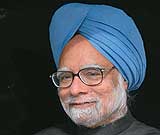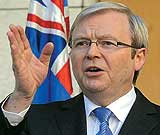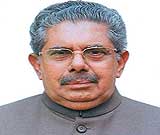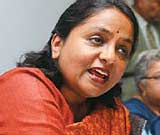|
In May, Indian Prime Minister Manmohan Singh had spoken to his Australian counterpart Kevin Rudd to voice concerns about the spate of attacks on Indian students in Australia. The attacks had been terribly disconcerting for not just the Indian community Down Under but also thousands of parents in India who have sent their children for studies and brighter career prospects in this southern hemispheric nation.
| GOPIO Australia Coordinator Amarinder Bajwa, GOPIO Regional Vice President Noel Lal and GOPIO chapter presidents Harry Walia and Jagidh Lodhia met Sujata Singh, India's High Commissioner in Canberra and discussed ways of helping out Indian students. They have organized fund raising for Rajesh Kumar who suffered 30% burn wounds in the Harris park petrol bomb incident. President of GOPIO’s Parramatta Chapter Amit Pall is providing legal aid where necessary |
Australia has named its intelligence chief Peter Varghese, an Indian-Australian and a close aide of Premier Kevin Rudd as its new High Commissioner to India. Varghese, the current head of the Office of National Assessments (ONA), will take over in August from John McCarthy, who has served in the job since 2004. He will also hold concurrent accreditation to Bhutan. Varghese served as Australia's High Commissioner to Malaysia from 2000 to 2002. He also served in Australian missions at Vienna, Washington and Tokyo |
Despite assurances from Rudd, the situation has not really improved, and the Indian student community of about 95,000 that spends hundreds of thousands of Australian dollars isn’t at peace. Some of the assaults have been mentally scarring, and (as reported in INDIA EMPIRE June edition) the attackers have quite often made it clear that Australia is full, and, therefore, there is no place for more Indians to come to the country.
 |
 |
 |
 |
|
“The Australian PM emphasized that Australia is a multi-cultural nation which respects and embraces diversity. He said that these incidents would be countered with the full force of the law”
Dr. Manmohan Singh
Prime Minister, India
|
“We strongly condemn the attacks on Indian students. But I reiterate that Australia is the safest place for international students to take education. It is unacceptable of people forming vigilante groups and launching revenge attacks”
Kevin Rudd
Prime Minister, Australia
|
“The Australian officials have come to meet me to assure that the Indian students have the full protection of the Australian Government. Things are under control except for stray incidents here or there”
Vayalar Ravi
Minister of Overseas Indian Affairs, India
|
“I do not think that Australia is a racist society, however, there are certain elements who have attacked these students and some of these attacks have not been opportunistic”
Sujatha Singh
High Commissioner of India to Australia
|
On July 2, Minister for Overseas Indian Affairs Vayalar Ravi informed Rajya Sabha (Upper House in Parliament), that 81 confirmed cases of attacks on Indians, including students, had been reported in Australia since May 23 this year. That amounted to more than two attacks per day. Ravi said that the seriousness of the matter had been conveyed to the Australian Government and it had been made clear that it was the responsibility of police authorities in Australia to ensure the well-being and security of Indian students in that country.
 |
 |
| |
|
 |
 |
| |
|
 |
FOR BETTER SENSE…: Placards carrying many slogans point to the same things, that it is time to stop attacks and work towards peace and harmony |
Fanning the fires of hatred and a lack of welcome are reports in the Australian media that 54 overseas students, half of them Indians, died of various causes in Australia in 2008. Alarmed by the reports, Indian Foreign Minister S.M Krishna announced that he would be going to Australia to find out more. While discussions on the deteriorating situation would be prime on his agenda, other issues of bilateral relationships would also get a look in.
The reports were sourced to the Federal Opposition that warned that the Department of Immigration ought to have sufficient data on foreigners entering the country in order to protect them during their stay. “The problem for us is not to know. If we know what type of deaths are occurring, where and when, whether it is virtually within weeks or months of the student’s arrival, it would enable us to deal better with these deaths,” Federal Opposition’s immigration spokeswoman Sharman Stone observed. She blamed the system for being haphazard and lacking in transparency. “If we don’t have that data, we can’t give our international students the very best of experiences in Australia and protect them from harm while they’re here.”
Stung by the reports, the Australian Government quickly debunked the figures, stating that they “did not contain accurate statistics.” It clarified that the articles relied on the Department of Immigration and Citizenship (DIAC) records on death for whatever reason (accident, illness or others), records that were less than reliable. “As DIAC is reliant on others to providing advice when a death has occurred, these records should not be used as a basis for determining the number of deaths or the cause of death of international students.”
RUDD IS DETERMINED
Amid all the controversy and heartburn, Rudd is determined to restore harmony and arrest Australia’s rapidly declining international image. He knows that the impact of the adverse publicity could directly affect the Australian education industry. It raked in over USD 12 billion in 2008, making the overseas students market the third largest export earner for his country behind coal and iron ore. Indian and Chinese students have played a big role in the boom. Their numbers rose 54 per cent last year, and have doubled in the past three years. With nearly 95,000 in the ranks, Indian students are second only to the Chinese when it comes to overseas students in Australia, who total nearly half a million.
|
Amid all the controversy and heartburn, Rudd is determined to restore harmony and arrest Australia’s rapidly declining international image. He knows that the impact of the adverse publicity could directly affect the robust Australian education industry |
Since Australia cannot afford to face setbacks to this cash-rich industry, the Prime Minister has decided to press all damage-control buttons. The first step is to send a high-level delegation to India to address the issue of attacks on Indian students. The delegation will essentially try to interact with Indian authorities and representatives to ensure that back home proper policies are in place to protect the welfare of every Indian student that finds his way in to Australian soil.
The decision has earned praise, but there is a wait-and-watch mood. The Federation of Indian Student Association (FISA) welcomed Rudd’s initiative but also threw in a few words of caution: “The terms of reference of the delegation must be properly articulated so that it does not turn out to be another expensive tax payer-funded marketing campaign in India in disguise.” FISA has also demanded that more funding be made available by city councils for student welfare as it has had to help out over 70 victims of crime without any support from the Australian Government. It also called for establishing a special division within the police to deal with the international students’ issue. Further, it has demanded that the Government set up improved regulatory frameworks. These would ensure that criminal charges are pressed against educational institutions that enticed Indian students with incorrect information and without having quality infrastructure.
|
The controls are not too bad. But it is the offshore agents that deliberately mislead students and that is a problem, especially for those enrolling for the cookery and hospitality sectors |
MORE THAN MEETS THE EYE
The attacks on Indian students could be seen as racial, but there is more than meets the eye. Laurie Ferguson, MP and Parliamentary Secretary for Multicultural Affairs and Settlement Services put it down to a cocktail of issues. “What is important here to understand is that there is not much connect between the established Indian order that comprises businessmen and academics, and the students. That is a concern too,” Ferguson says. “We can keep a track of the onshore agents of the institutes. The controls are not too bad. But it is the offshore agents that deliberately mislead students and that is a problem, especially for those enrolling for the cookery and hospitality sectors,” said Ferguson.
“Indians are hardworking, peaceful and also bright. Sure, some of them might be enticed by the Permanent Residency route but they need to be careful considering that they have not been fully apprised of the ordeals they face here.”
Very quickly, both Australia and India need to work out ways—politically, administratively, and diplomatically—in which the rot can be stemmed. Else, Indian parents will soon be prospecting other destinations to send their children to study, well away from the shores of Australia.
|